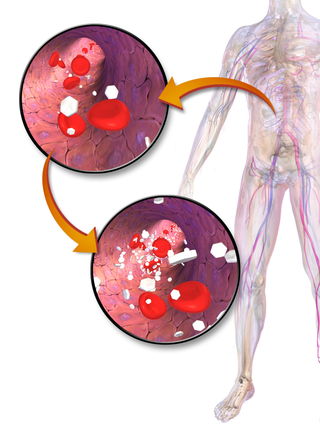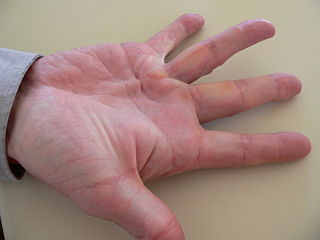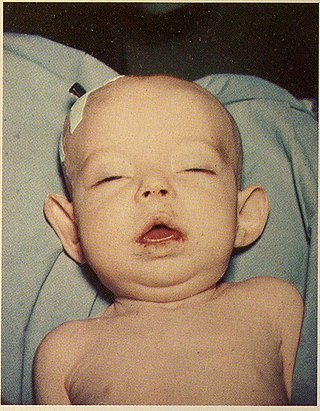Related Research Articles
The following is a glossary of diabetes which explains terms connected with diabetes.

Hyperglycemia is a condition in which an excessive amount of glucose circulates in the blood plasma. This is generally a blood sugar level higher than 11.1 mmol/L (200 mg/dL), but symptoms may not start to become noticeable until even higher values such as 13.9–16.7 mmol/L (~250–300 mg/dL). A subject with a consistent range between ~5.6 and ~7 mmol/L is considered slightly hyperglycemic, and above 7 mmol/L is generally held to have diabetes. For diabetics, glucose levels that are considered to be too hyperglycemic can vary from person to person, mainly due to the person's renal threshold of glucose and overall glucose tolerance. On average, however, chronic levels above 10–12 mmol/L (180–216 mg/dL) can produce noticeable organ damage over time.
Lipodystrophy syndromes are a group of genetic or acquired disorders in which the body is unable to produce and maintain healthy fat tissue. The medical condition is characterized by abnormal or degenerative conditions of the body's adipose tissue. A more specific term, lipoatrophy, is used when describing the loss of fat from one area. This condition is also characterized by a lack of circulating leptin which may lead to osteosclerosis. The absence of fat tissue is associated with insulin resistance, hypertriglyceridemia, non-alcoholic fatty liver disease (NAFLD) and metabolic syndrome.
Diabetic neuropathy is various types of nerve damage associated with diabetes mellitus. Symptoms depend on the site of nerve damage and can include motor changes such as weakness; sensory symptoms such as numbness, tingling, or pain; or autonomic changes such as urinary symptoms. These changes are thought to result from a microvascular injury involving small blood vessels that supply nerves. Relatively common conditions which may be associated with diabetic neuropathy include distal symmetric polyneuropathy; third, fourth, or sixth cranial nerve palsy; mononeuropathy; mononeuropathy multiplex; diabetic amyotrophy; and autonomic neuropathy.

Dupuytren's contracture is a condition in which one or more fingers become permanently bent in a flexed position. It is named after Guillaume Dupuytren, who first described the underlying mechanism of action, followed by the first successful operation in 1831 and publication of the results in The Lancet in 1834. It usually begins as small, hard nodules just under the skin of the palm, then worsens over time until the fingers can no longer be fully straightened. While typically not painful, some aching or itching may be present. The ring finger followed by the little and middle fingers are most commonly affected. It can affect one or both hands. The condition can interfere with activities such as preparing food, writing, putting the hand in a tight pocket, putting on gloves, or shaking hands.

Palmoplantar keratodermas are a heterogeneous group of disorders characterized by abnormal thickening of the stratum corneum of the palms and soles.
A complication in medicine, or medical complication, is an unfavorable result of a disease, health condition, or treatment. Complications may adversely affect the prognosis, or outcome, of a disease. Complications generally involve a worsening in the severity of the disease or the development of new signs, symptoms, or pathological changes that may become widespread throughout the body and affect other organ systems. Thus, complications may lead to the development of new diseases resulting from previously existing diseases. Complications may also arise as a result of various treatments.
Sclerodactyly is a localized thickening and tightness of the skin of the fingers or toes that yields a characteristic claw-like appearance and spindle shape of the affected digits, and renders them immobile or of limited mobility. The thickened, discolored patches of skin are called morphea, and may involve connective tissue below the skin, as well as muscle and other tissues. Sclerodactyly is often preceded by months or even years by Raynaud's phenomenon when it is part of systemic scleroderma.

Onychomycosis, also known as tinea unguium, is a fungal infection of the nail. Symptoms may include white or yellow nail discoloration, thickening of the nail, and separation of the nail from the nail bed. Toenails or fingernails may be affected, but it is more common for toenails. Complications may include cellulitis of the lower leg. A number of different types of fungus can cause onychomycosis, including dermatophytes and Fusarium. Risk factors include athlete's foot, other nail diseases, exposure to someone with the condition, peripheral vascular disease, and poor immune function. The diagnosis is generally suspected based on the appearance and confirmed by laboratory testing.

Necrolytic migratory erythema is a red, blistering rash that spreads across the skin. It particularly affects the skin around the mouth and distal extremities; but may also be found on the lower abdomen, buttocks, perineum, and groin. It is strongly associated with glucagonoma, a glucagon-producing tumor of the pancreas, but is also seen in a number of other conditions including liver disease and intestinal malabsorption.
Acquired generalized lipodystrophy is a rare skin condition that appears during childhood or adolescence, characterized by fat loss affecting large areas of the body, particularly the face, arms, and legs. There are 4 types of lipodystrophy based on its onset and areas affected: acquired or inherited, and generalized or partial. Both acquired or inherited lipodystrophy present as loss of adipose tissues, in the absence of nutritional deprivation. The near-total loss of subcutaneous adipose tissue is termed generalized lipodystrophy while the selective loss of adipose tissues is denoted as partial lipodystrophy. Thus, as the name suggests, AGL is a near-total deficiency of adipose tissues in the body that is developed later in life. It is an extremely rare disease that only about 100 cases are reported worldwide. There are three main etiologies of AGL suspected: autoimmune, panniculitis-associated, or idiopathic. After its onset, the disease progresses over a few days, weeks, months, or even in years. Clinical presentations of AGL are similar to other lipodystrophies, including metabolic complications and hypoleptinemia. Treatments are also similar and mainly supportive for symptomatic alleviation. Although HIV- or drug-induced lipodystrophy are a type of acquired lipodystrophy, its origin is very specific and distinct hence is usually not discussed with AGL.
Familial partial lipodystrophy, also known as Köbberling–Dunnigan syndrome, is a rare genetic metabolic condition characterized by the loss of subcutaneous fat.
A diabetic bulla is a cutaneous condition characterized by a noninflammatory, spontaneous, painless blister, often in acral locations, seen in diabetic patients.
Waxy skin is a cutaneous condition observed in roughly 50% of diabetic patients with longstanding disease.
Diabetic dermadromes constitute a group of cutaneous conditions commonly seen in people with diabetes with longstanding disease. Conditions included in this group are:
Complications of diabetes mellitus include problems that develop rapidly (acute) or over time (chronic) and may affect many organ systems. The complications of diabetes can dramatically impair quality of life and cause long-lasting disability. Overall, complications are far less common and less severe in people with well-controlled blood sugar levels. Some non-modifiable risk factors such as age at diabetes onset, type of diabetes, gender and genetics may influence risk. Other health problems compound the chronic complications of diabetes such as smoking, obesity, high blood pressure, elevated cholesterol levels, and lack of regular exercise. Complications of diabetes are a strong risk factor for severe COVID-19 illness.
Haim–Munk syndrome is a skin disease caused, like Papillon-Lefevre Syndrome, by a mutation in the cathepsin C gene. One of its features is thick curved finger and toenails.
Stiff skin syndrome is a cutaneous condition characterized by ‘rock hard’ induration, thickening of the skin and subcutaneous tissues, limited joint mobility, and mild hypertrichosis in infancy or early childhood. Immunologic abnormalities or vascular hyperactivity are not present in patients.

Bowel-associated dermatosis–arthritis syndrome (BADAS), is a complication of jejunoileal bypass surgery consisting of flu-like symptoms, multiple painful joints (polyarthralgia), muscle aches (myalgia) and skin changes. It has been reported to occur in up to 20% of patients who had jejunoileal bypass surgery, a form of obesity surgery that is rarely performed today.

Donohue syndrome is an extremely rare and severe genetic disorder. Leprechaunism derives its name from the hallmark elvish features exhibited by the affected individuals. The disease is caused by a mutation in the INSR gene, which contains the genetic information for the formation of insulin receptors. As a result, affected individuals have either a decreased number of insulin receptors, or insulin receptor with greatly impaired functionality. The lack and impairment of insulin receptor functionality leads to an inability to regulate blood glucose levels through severe insulin resistance. This will ultimately lead to affected development of tissues and organs throughout the body. In addition to the physical abnormalities, leprechaunism is also characterized by endocrine system abnormalities that can lead to conditions such as hyperglycemia, hypoglycemia, hyperinsulemia, and the enlargement of certain sex organs such as the penis in males, and the clitoris in females.
References
- ↑ Rapini, Ronald P.; Bolognia, Jean L.; Jorizzo, Joseph L. (2007). Dermatology: 2-Volume Set. St. Louis: Mosby. ISBN 978-1-4160-2999-1.
- ↑ James, William D.; Berger, Timothy G.; et al. (2006). Andrews' Diseases of the Skin: clinical Dermatology. Saunders Elsevier. ISBN 978-0-7216-2921-6.
- ↑ Lindsay JR, Kennedy L, Atkinson AB, Bell PM, Carson DJ, McCance DR, Hunter SJ (March 2005). "Reduced prevalence of limited joint mobility in type 1 diabetes in a U.K. clinic population over a 20-year period". Diabetes Care. 28 (3): 658–61. doi: 10.2337/diacare.28.3.658 . PMID 15735204.
- 1 2 Hill NE, Roscoe D, Stacey MJ, Chew S (August 2019). "Cheiroarthropathy and tendinopathy in diabetes". Diabet Med. 36 (8): 939–947. doi:10.1111/dme.13955. hdl: 10044/1/80365 . PMID 30920669.